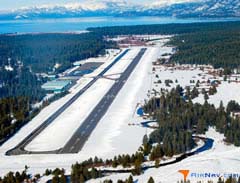 More than 100 people packed into the South Lake Tahoe City Council Chambers for an opening-round workshop on a master plan being put together for the Lake Tahoe Airport.
More than 100 people packed into the South Lake Tahoe City Council Chambers for an opening-round workshop on a master plan being put together for the Lake Tahoe Airport.
City officials and consultants with C&S Companies hired to complete the $350,000 study – 90 percent paid for by the Federal Aviation Administration – were pleased with the strong turnout.
It was standing-room only in the former terminal converted into council chambers and other city offices after commercial flight service ended at the city-owned airport in 2000.
Exploring the feasibility of bringing commercial service back is just one aspect of the master plan, an airport development planning tool required by FAA for airports it funds.
Councilman Tom Davis called it the biggest showing he’s seen at an airport meeting in 30 years. “That’s encouraging. We need your input, good, bad or indifferent,” he said.
Michael Hotaling of C&S Companies described the master plan process and fielded about 45 minutes of questions and comments.
The last master plan for Lake Tahoe Airport was in 1992. Since then, a lot has change in South Lake Tahoe and the aviation industry, including some airport design standards, Hotaling said.
The master plan process includes a survey of airport conditions and facility needs, environmental constraints, an aircraft inventory and estimated 20-year aviation demand and capacity forecasts to help drive the selection of facility alternatives for evaluation.
Overseen by FAA, the process concludes with a preferred development alternative and a proposed airport layout plan. That will include cost estimates for a demand-driven capital improvement schedule, maintenance plans and funding strategies.
The planning process is expected to take about one year. The document then would be considered for adoption by the South Lake Tahoe City Council and Tahoe Regional Planning Agency.
The process will involve at least two more public meetings as information in the master plan takes shape.
“The most important piece is this green line at the top, community input,” Hotaling said, pointing to a diagram of the master plan’s timeline. “That is continuous throughout this process.”
City officials and consultants got an earful of input from people seemingly on all sides of the airport issue Thursday.
Some people asked if the master plan will explore closing the airport. Some people wanted to know if the airport could be scaled back to serve only helicopters or small aircraft.
Other people asked for an additional study looking at the airport’s economic impact for South Lake Tahoe and the basin.
Others still, including South Lake Tahoe resident Michael Willner, said they want to see the airport more heavily utilized as an asset.
While the airport has been limited to general aviation use after several decades of commercial service, it does retain a part 139 certification allowing commercial service and has an 8,451-foot runway capable of serving aircraft up to 230,000 pounds, Hotaling said.
Hotaling also discussed use of the airport by Calstar and by firefighters during the Angora Fire as evidence of its benefit for the community.
Closing the airport is not likely to be evaluated as an alternative, according to Hotaling. Over the last 14 years, South Lake Tahoe has accepted more than $27 million in FAA grant money to improve the airport, money that essentially obligates the city to keep it open.
“Under grant assurances, if it’s closed, one sticky issue is the FAA wants that money back. That’s one, there’s a lot more,” Hotaling said.
The city has subsidized the Lake Tahoe Airport with about $400,000 per year from its general fund. But that amount will fall to about $200,000 after debt for a hangar project is retired this year, City Manager Nancy Kerry said. (CalPilots Editor’s Note: The question here is, does the city, which is the aiport sponsor, pay fair market rent on the space it accupies at the airport? If not, then that amount must be removed from the “subsidy” figure.)
Asked at one point to outline some of the biggest concerns that will surface, Hotaling said he sees three to five top issues.
“How does this airport operate and balance in the surrounding environment, how does it best function and minimize investment by the city, be the most economically sustainable, how do you best serve the needs of the region and how do you best provide services pilots want without investing more than you have to,” he said.
Airport History
1959: El Dorado County builds airport to promote tourism, improve public safety and support Winter Olympics.
1962: Runway is extended from 5,900 to 8,541 feet.
1970s: Commercial service increases and peaks at 294,188 yearly enplanements in 1978.
1983: City of South Lake Tahoe buys the airport for $1.
1992: Airport master plan completed.
2000: Commercial flight service ends. Start of general aviation operations only.
2004: Traffic control tower closes.
2008: Runway rebuilt and narrowed. Restores about 205,000 square feet of stream environment.
2011: About 24,000 annual flights by charter and general aviation pilots. Nearly 80 percent of the flights are visitors.
Source: South Lake Tahoe, C&S Companies
For more information:
http://www.cityofslt.us/airport
